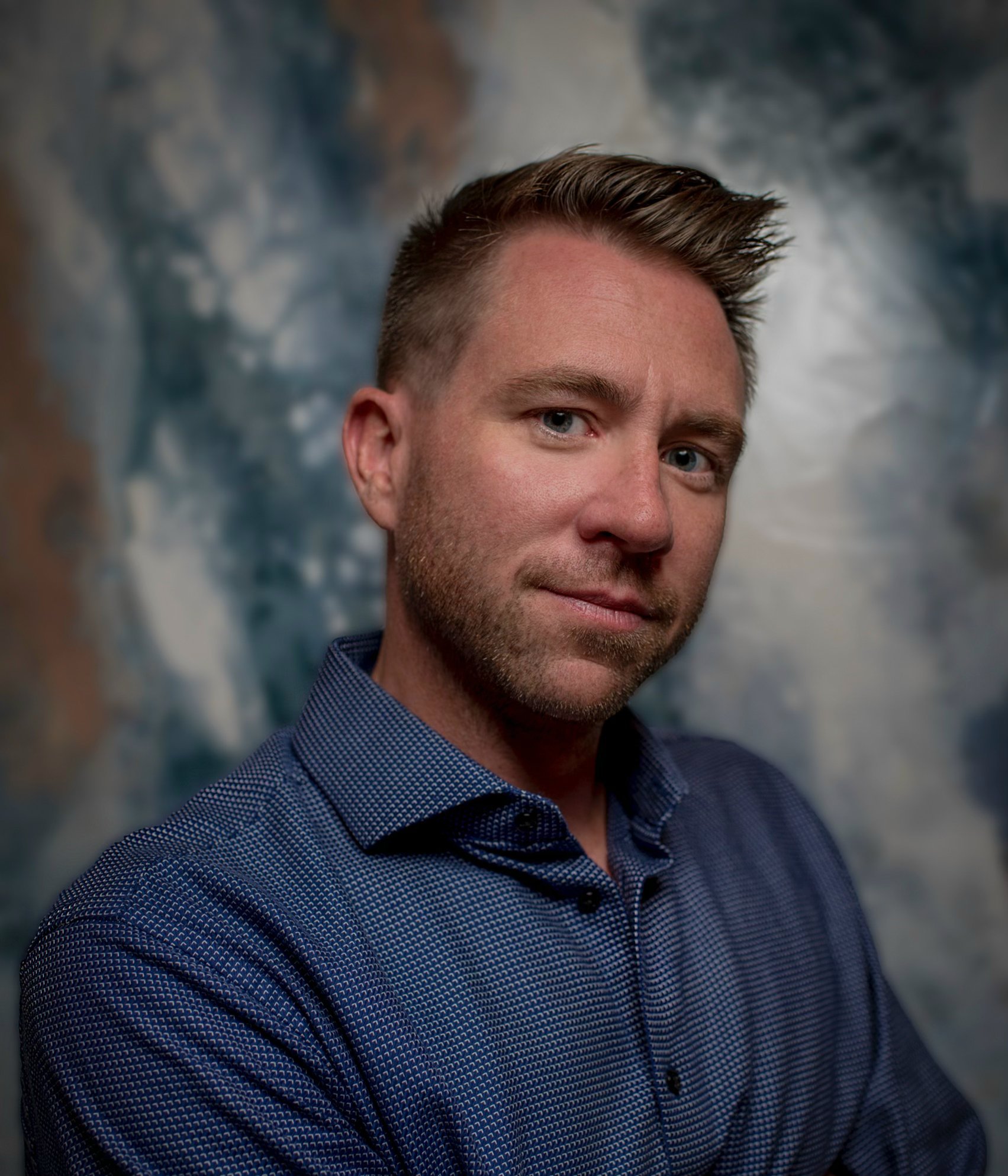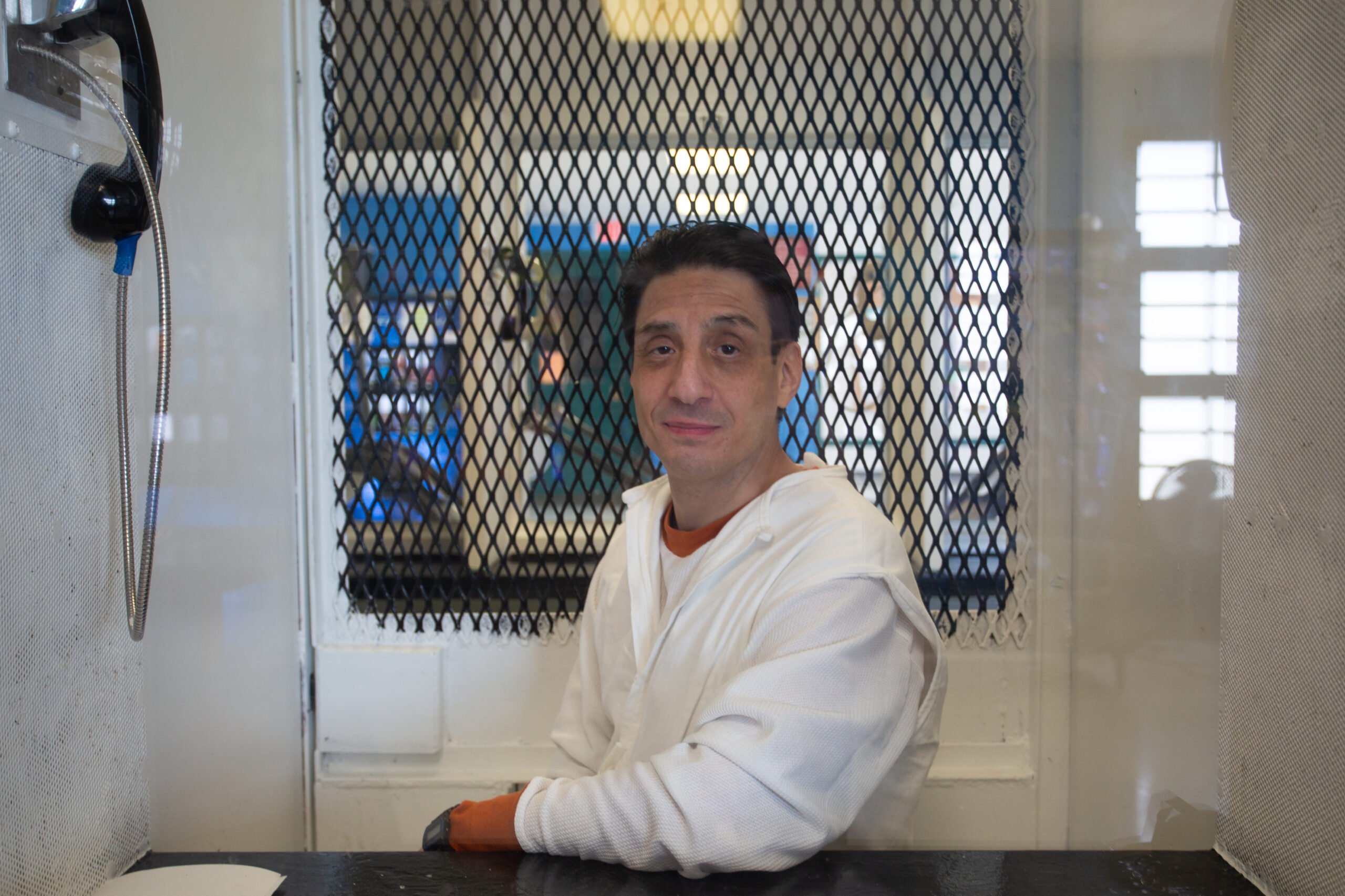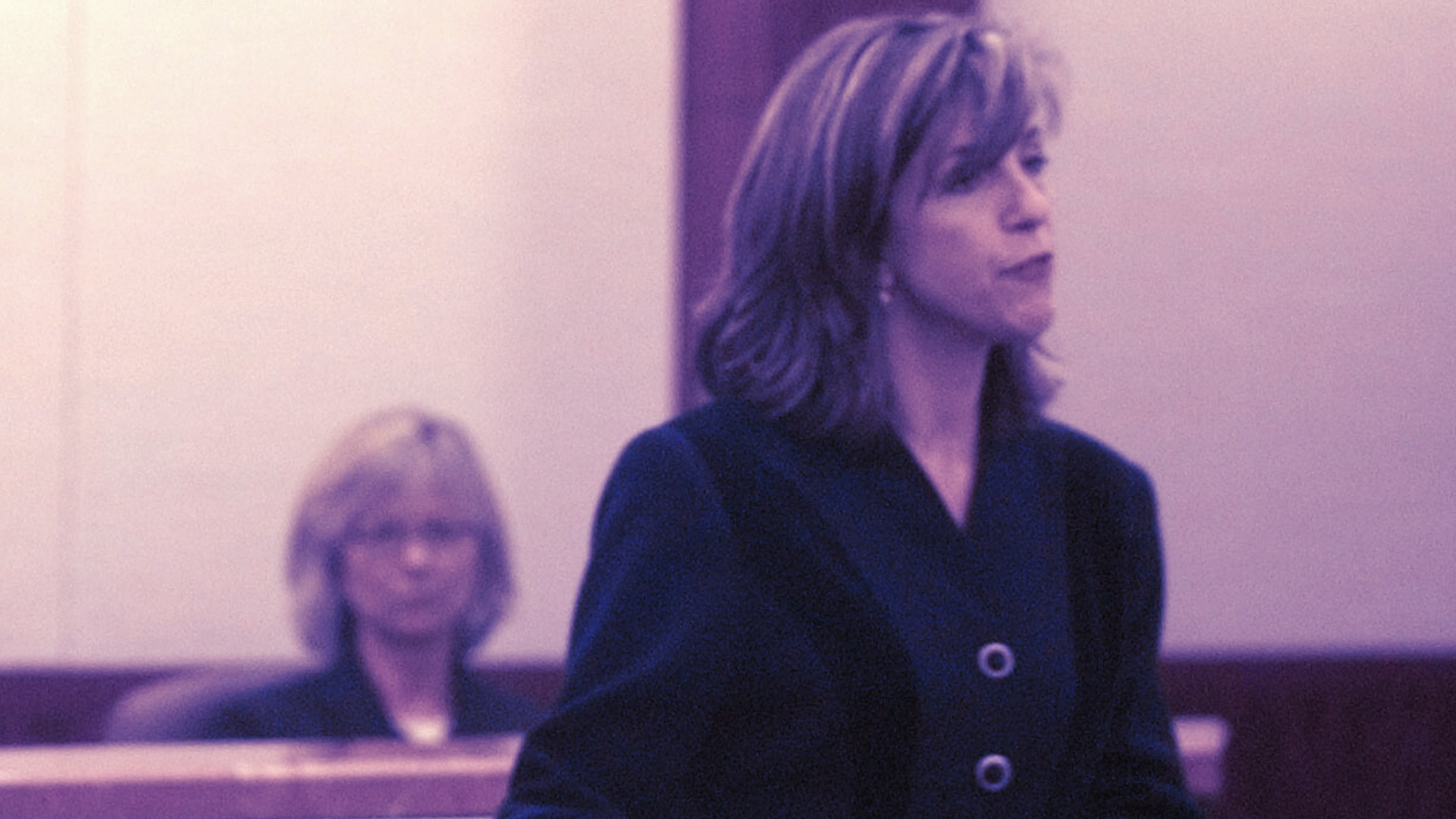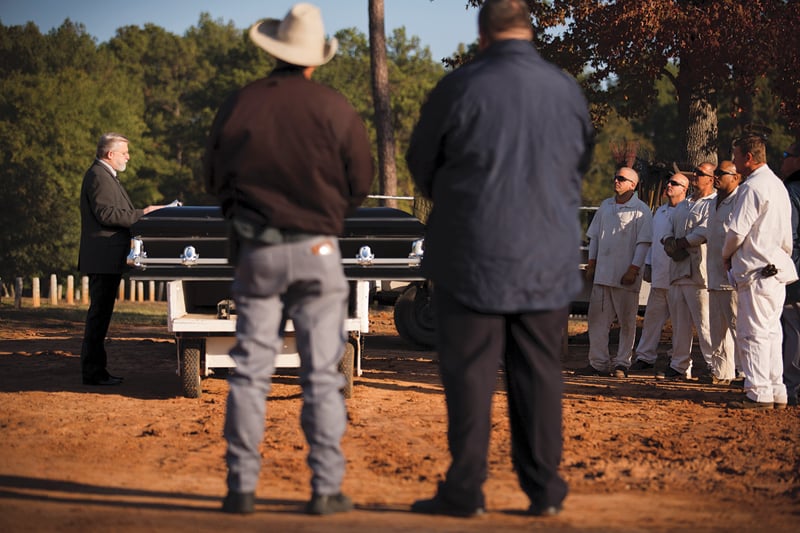
Laid to Rest in Huntsville
Of the roughly 450 inmates who die in Texas prisons each year, about 100 are laid to rest in Captain Joe Byrd Cemetery in Huntsville.
A version of this story ran in the March 2014 issue.
Above: Prison Chaplain Larry Hart leads guards and inmate trusties in prayer during a burial at TDCJ’s Captain Joe Byrd Cemetery in Huntsville.
A steady rain has turned the red dirt of Captain Joe Byrd Cemetery to mud. A dozen people gather next to open graves beneath the loblolly pines to attend the funerals of two men they never met. The only splashes of color on this gray Thursday are the pallbearers’ yellow prison-issue rain slickers.
The funeral party is waiting for two bodies and one family to arrive from nearby Grace Baptist Church, where a visitation was held. That viewing is part of the modest funeral service the state provides for inmates who die while incarcerated and whose bodies aren’t claimed by their families. These bodies are buried in this prison cemetery in Huntsville, where an estimated 3,000 people have been interred since it was established in 1855. Their graves are dug and their services attended by a crew of inmates from the nearby Walls Unit.
It’s the morning after an execution, and the warden, chaplain and public information officer were all at work until midnight. Everyone with a professional title instead of a prison number is tired. Steam rises from Warden James Jones’ coffee cup as he visits with Chaplain David Collier Sr., who, in his giant translucent rain poncho, looks like a waterlogged Santa. Then Collier gets the word: The family that attended the church visitation has decided not to attend the graveside service. So both of today’s funerals will be “directs,” the Texas Department of Criminal Justice (TDCJ) term for burials with no family present. The two deceased died of natural causes; the family of last night’s executed man claimed his body.
A car arrives from the funeral home carrying two caskets and the inmate crew moves them to a white cart next to the graves. Collier extracts a small Bible and a piece of notepaper from his pocket and puts a hand on one of the caskets. Black, with silver trim, it strikes the same somber note as any coffin in the free world. A prison staffer steps forward and places a handkerchief over the Bible to shield it from the rain.
“Fellas,” Collier says to the eight slicker-clad inmates before him, “we gather to bury this man, who was a Christian. He passed away at the hospital in Galveston.” He reads the man’s name and age from his notes.
“And this man,” he says, placing his hand on the other casket, “was a Baptist by faith. He died at the hospice care facility, and he could very well have been there awhile.” Collier pushes his glasses up on his nose and checks his notes. “I’m trying to think if there’s any other pertinent information.”
He quotes the books of Matthew and Hebrews. He speaks of the afterlife: “Everybody wants to go to heaven, they just don’t want to go today.” A few of the men nod; others look at their feet. “The question is, are you ready? Today is the first day of the rest of your life. Let’s close with a prayer.
“Our most kindly, loving, heavenly Father, we thank you for sparing our life through the night. We ask that you be with these men and these officers and that you make us strong and serve you. However, we are human, and we all fail you from time to time. We ask that you please forgive us and that you be with us all. All these things we ask you in Jesus’ name.”
The combined service for the two men takes a little less than 10 minutes. When it’s over, Collier steps away from the caskets and the crew begins lowering the coffins into the ground.
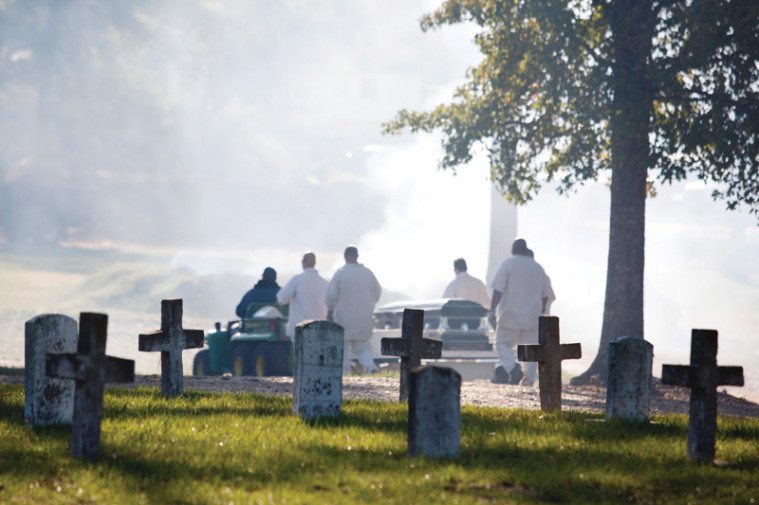
Of the roughly 450 inmates who die in Texas prisons each year, about 100 are laid to rest in Captain Joe Byrd Cemetery. Whether they die in one of the state’s 109 prison units, at the TDCJ hospital in Galveston, or at the prison system’s hospice facility near Palestine, the inmate’s family has the option to claim the body and make funeral arrangements of their choice. When family members can’t be located, or when they decline to claim the body, the state picks up the tab for the funeral and buries the body in TDCJ’s Byrd Cemetery.
The most common reason families don’t claim the body is that they can’t afford to, Chaplain Collier says. Some, like the family that attended today’s visitation at Grace Baptist Church, will decline to claim the body but then attend services in Huntsville. Prison funerals are generally held on Thursdays, unless the deceased has been executed, in which case the burial is often performed the following day; the accelerated schedule saves families who come to witness the execution from having to make a second trip to Huntsville. A typical Thursday may have one or two funerals. Collier says he’s done as many as nine in one day.
He estimates that 60 percent of the services he performs are directs. Sometimes next of kin can’t be located. Other families can’t afford to travel to Huntsville. “You’ve got some that may be in Amarillo, and to come down here is too much,” Collier says. “And I buried one last week that was 80-something years of age, and he probably outlived most of his family.”
If no family or friends attend, the inmates of the cemetery grounds crew stand witness in their stead. These “offenders,” as TDCJ calls them, typically don’t know the deceased, unless the person died at the Walls Unit.
“It’s humbling,” says Lawerence Lacour, 26, who digs graves and serves as a pallbearer. He’s done other manual labor in the four years he’s served on a drug-related sentence, but this is different. “Especially as a Christian, in this situation I think that I could myself die, because tomorrow’s not promised to anybody.”
Captain Joe Byrd Cemetery is around the corner from the Sam Houston State University campus, and a brand-new fraternity house is so close to the grounds that it could be confused with a visitor center. The nearby roads are busy during Huntsville’s rush hour, and there’s a car wash across the street. But among the graves there is a palpable, pensive quiet that thickens the cemetery air.
The graveyard was originally known as “Peckerwood Hill,” an inmate slang term referring to its indigent occupants. It was renamed for an assistant warden at the Walls Unit who in the 1960s initiated a cleanup of the neglected grounds. Today, neat rows of grave markers—some flat stones, some crosses made of rebar-reinforced concrete—cover the gently sloping hill. The cemetery crew makes the markers onsite in a small shed. Some headstones include the inmate’s name and dates of birth and death. During the 1980s and ’90s the concrete crosses included only prison numbers and dates of death.
If the inmate was executed, the headstone bears the letters “X” or “EX,” or a prison number beginning “999”—the designation for death row.
The 22-acre cemetery can be crossed on foot in less than 10 minutes. Though some graves have collapsed as the soil shifts, the grounds are neatly maintained. A low-lying swath of the property is empty, but the space is finite; Warden Jones estimates the cemetery will be full in another three years. That’s because more people are being buried here than in the past. More than half of the graves date from the 1980s and later.
“It’s a reflection of the imprisonment boom of the ’80s and ’90s,” says Franklin Wilson, an assistant professor of criminology and criminal justice at Indiana State University who is writing a book about the cemetery. “We imprison a higher percentage of our population than any other Western industrialized country. And then you consider who we imprison, the majority of which are the poor,” and it makes sense that more people would end up in the cemetery, he says.
When Wilson was working on his Ph.D. at Sam Houston State University next door, his jogging route took him past the cemetery. “Always in my mind was: What happens in a person’s life to where they end up in the ultimate pauper’s graveyard? Why are these people here? What is the story behind each of them?”
In the summer of 2011, Wilson photographed every headstone and made a map of the cemetery. His study showed that at least 30 to 40 veterans are buried there. Wilson researched the story of one grave and learned that its occupant had returned from the war in Vietnam, worked in a factory, become addicted to drugs, and ended up killing an elderly woman in Texas. “He was executed but received a full military funeral at the time. But when you look at his story today, you would know he was suffering from PTSD, and there might be services that would help him, whereas back then there weren’t. It makes you wonder what other things are resulting in people ending up there that we are maybe missing today.”
Several dozen graves show evidence of being visited. A heart-shaped tinsel wreath is firmly tied with twine to a concrete cross bearing only a prison number and date of death. The headstone for Derrick O’Brien, executed in 2006 for the rape and murder of a 14-year-old girl, is flanked by faded artificial peonies and a small cross bearing the words of John 15:12: “My command is this: Love each other as I have loved you.”
Dead carnations lie at the foot of some stones, their dried stems blending in with fallen pine needles. The flowers are left from a Texas Interfaith Center for Public Policy event on All Souls’ Day and Dia de los Muertos last November. About 50 volunteers of various religious backgrounds laid a single long-stemmed carnation at each grave, standing over it long enough to say a prayer or remembrance.
“These people are often forgotten,” says Cindy Eigler, a policy specialist on criminal justice issues who organized the event. “As a community of faith, this was a kind of a chance to say, ‘We remember you, we recognize your inherent worth, we recognize your humanity, you’re not forgotten for us.’
“Our main purpose was just to lay the flower, and to recognize the humanity of the individuals in TDCJ and those who died there—but to remember at the same time that while there are 3,000 people buried in that ground, there are 150,000 who are incarcerated currently behind the walls, and to also remember their inherent worth.”
A typical funeral Thursday starts before 7 a.m. when the bodies are delivered to Grace Baptist Church, two miles from the cemetery. Each decedent—there are usually two or three—gets a section of the modest church auditorium, a windowless, brown-paneled room with wooden pews. Pastor David Beaty and staff from Texas City-based Carnes Funeral Home open each casket, “set all the pretties around it,” and make sure the bodies haven’t shifted in transit. Someone from the church brews coffee in the foyer.
Family members arrive at 7:30, gathering in their corner of the auditorium, and the first group goes up the street to the cemetery around 9 a.m. In the meantime, Collier is conducting the day’s directs. “The common phrase I hear is, ‘I wasn’t expecting anything like this,’” Beaty says. “[The families] didn’t realize there would be a time of viewing, they didn’t realize [the deceased] would be dressed in a suit, that they were going to be as presentable as we can make them. Many of the men look like they could have been in church last Sunday.”
Many families haven’t been in contact with their incarcerated relatives for years, he says, and come to the funeral only out of obligation. He remembers a funeral several months ago for a woman whose three children hadn’t seen her in 20 years. Because the mother’s crime was abuse, the state had placed the children with relatives and foster families and prevented their mother from contacting them. In recent years the children had reestablished contact with one another, but they hadn’t seen their mother. “Yet they still had love in their heart for their mom, and compassion.”
Conversely, he says, the family at one recent service arrived with a mix of animosity and obligation. The 64-year-old deceased offender had been serving a sentence for sexual assault, and his case included abuse of young family members. “This was their father, and they felt like they owed their father a funeral service,” Beaty says. “But after they’d viewed the body and they let their emotions out, it was very evident they were ready to go. They kept looking at their watch and saying, ‘I have to get back to work.’” Beaty asked if he could pray with the family at the church in lieu of them making the trip to the cemetery, and after they’d left he called Chaplain Collier to tell him the service had become a direct.
When families do come to the cemetery, Collier meets them for a brief service at a small covered pavilion. Then the body is moved down the hill to the grave, and the next group is summoned from
the church.
Jim Willett, who served as warden at the Walls Unit from 1998 to 2001 and now directs the Texas Prison Museum in Huntsville, estimates he went to 75 percent of the funerals at Captain Joe Byrd Cemetery during his tenure. He remembers a few families bringing their own clergy or someone to sing. One funeral for a young inmate drew his mother, grandmother and sister from Arkansas. The mother brought a portable stereo and asked if she could play a song during the service. When the moment came, the music turned out to be “Dear Mama” by rap artist 2Pac.
“I listened to the words, and it was really good and appropriate, but a rap song out of those country-looking folks from Arkansas was the last thing I expected to hear,” he says.
Sometimes families come simply for closure. Jim Brazzil, who as Walls Unit chaplain officiated 600 inmate funerals between 1995 and 2001, remembers one funeral for an inmate he’d never met. After the service he asked if any of the roughly 15 people who’d come to the funeral wanted to share their thoughts about the deceased, and a young man said he would. “He walked up there beside me, looked at the grave, then at me, then at the people, and said, ‘Most of you know I’m only here to make sure the son of a bitch is dead,’” Brazzil says. “It gave him an opportunity to vent about his father.”
Another funeral Brazzil led was for a sex offender whose entire family attended the service. After Brazzil had spoken, the inmate crew lowered the casket into the ground. At that moment the dead man’s grandson, about 4 years old, ran up beside the grave, pulled his pants down, and urinated on the casket. “Not one family member moved to stop him,” Brazzil says.
During his years as chaplain, Brazzil realized how starved the inmates were for physical touch, and how their families longed to touch them. During family visits, inmates and their relatives were usually separated by a glass wall. “Mothers always want to hug their kid, but the whole time their kid is in prison they don’t get to,” he says. On the day of their execution, death row inmates would say goodbye to their families at the Polunsky Unit, where they had been confined. That afternoon they would reunite at the execution chamber, but once again the relatives would be separated from the inmate by a glass wall. “They’re 4 feet apart, so close, and they can talk to him and hear him but not touch him,” Brazzil says. And then the inmate is executed.
Having watched that dynamic unfold, Brazzil worked out an arrangement with the warden and a local church. Immediately after an execution, prison staff would place the body on a gurney and let the family visit it at the church. It was the first time in years that family members had been able to touch their relative. “The body was still warm,” Brazzil says. “It became a meaningful time for the families, before the body became cold and stiff.”
“Dignity” and “respect” are frequently used vocabulary for those who arrange prison funerals. Dignity costs about $2,000 per inmate. Carnes Funeral Home, which holds the contract for funeral arrangements, applies the sum to transportation of the body, embalming, visitation at the church, a casket and outer burial container, and the clothes the deceased are buried in. (James Smith, the funeral director for the TDCJ contract, says he scours resale stores like Goodwill looking for suits and ties for the men and suits and dresses for the women.) By contrast, the average cost of a funeral in the free world is $7,000 to $8,000, excluding cemetery expenses. The more economical option of cremation is not used for prison funerals because it is less widely accepted, and because estranged family members sometimes learn about an inmate’s death months after the fact and want the body moved to a different cemetery.
Cemetery crew who attend the services are “outside trusties” who are allowed to work outside the perimeter fence with limited supervision. Many are involved in Christian prison programs like choir, Collier says. And they’re in relatively good physical health.
The Walls Unit houses lots of older offenders with health issues, Warden Jones says, so officers sometimes import trusties from other units to do the physically demanding cemetery labor. The graves used to be dug by hand, says Willett, the former Walls Unit warden. A crew of 10 inmates with shovels could finish the job in a few hours. Today a backhoe is used, but the men still have to carry heavy caskets.
And men may be assigned to the cemetery crew for reasons other than physical strength. “If you’ve got a guy that needs an attitude adjustment, sometimes we’ll move guys around and put them on the cemetery squad,” Jones says. “A lot of guys don’t like working out there because everybody takes death differently. Hopefully it changes his thinking about being in prison and not wanting to die in prison.”
The day after Coree Kennedy, 32, was transferred to the Walls Unit, he helped with a burial. Kennedy, serving a seven-year sentence for selling drugs, said the work has made him look at life differently.
“It really makes you think—do you want to be buried in here, or do you want to be with your loved ones with your family to surround you?” he says. “I’ve never done anything like this, to bury somebody that you don’t know, but still have compassion for the person that you’re burying.”
Asked what he wants said at his funeral, he suggests everyone wants the same thing: “That I was a good person in life. Just because you’ve been to prison doesn’t mean you can’t change and get out and do better.”
That’s the message Collier tries to impart at each graveside service.
“It’s only to the living I can speak, so I just say things to those men to hopefully make them leave here thinking, ‘You’re going to face this fate one day,’” he says. “Not knowing the offender, and with no family here, I just try to appeal to those fellows on the yard crew working out there.”
Collier identifies as a Church of Christ minister. He says most of his services have a distinctly Christian character. The information he pulls from TDCJ records includes the decedent’s religion, which is often recorded as Christian. If family members are attending the service, he’ll greet them and casually mention this information. “If I say, ‘I understand John was a Baptist,’ and they say, ‘Yeah,’ that lets me know this is a Christian group,” he says. He has notes for three or four standard services written in his Bible.
When records list a non-Christian faith, Collier will sometimes recruit clergy of that religion to perform the service. He’s worked with the Islamic Society of Greater Houston and a Native American officiant, but it’s not always easy to find someone, he says, especially if the family is not involved. If the inmate has filled out paperwork declaring that he’s Jewish or Muslim, the Islamic Society or a Jewish burial society usually claim those bodies, as their funeral practices are different and do not include embalming.
When family members do attend the service, they may not all share the religion of the deceased, especially if the offender converted while in prison. “They change their faith in here like they change their underwear,” Collier says.
But even when the deceased was known to be an atheist, Collier’s basic graveside message is the same, and focused on the living. “I really leave [the deceased] alone because there’s nothing I can say or do,” he says. “I can’t preach them into heaven or hell.”
The vast majority of executed inmates’ bodies are claimed by their families. Only a small percentage of the headstones in Captain Joe Byrd Cemetery bear an X or EX. Smith says he’s made arrangements for only two executed inmates whose bodies weren’t claimed by the family.
Smith has exchanged letters with a few prisoners, including some on death row, about the arrangements they want made for their funerals. He says it’s surreal to correspond with someone who knows what very few humans do: the exact date of their death. But whether they know when it’s coming or not, Smith says, death is the great leveler.
“It’s my belief that no matter what somebody did to end up in prison, whenever they pass away, all sins are paid on death,” he says. “The only person that can judge you when you pass away is God, and the only thing we can do for you is give you a proper burial and treat you with the same respect we would treat anyone else.”
Ten days after the rain-soaked funerals of late January, the cemetery’s red clay is still sticky and slick. College men finishing a jog on Bowers Avenue walk up the driveway to the fraternity house and disappear through the doors. A stone’s throw away, the freshly filled graves are tidy and quiet. Carnes Funeral Home has provided temporary markers that will be replaced by permanent stones when the inmates finish them. The disturbed dirt has been flattened by a tractor, smoothed into a clean slate for next spring’s new grass. Nearby, four more freshly dug graves are waiting.
To support journalism like this, donate to the Texas Observer.